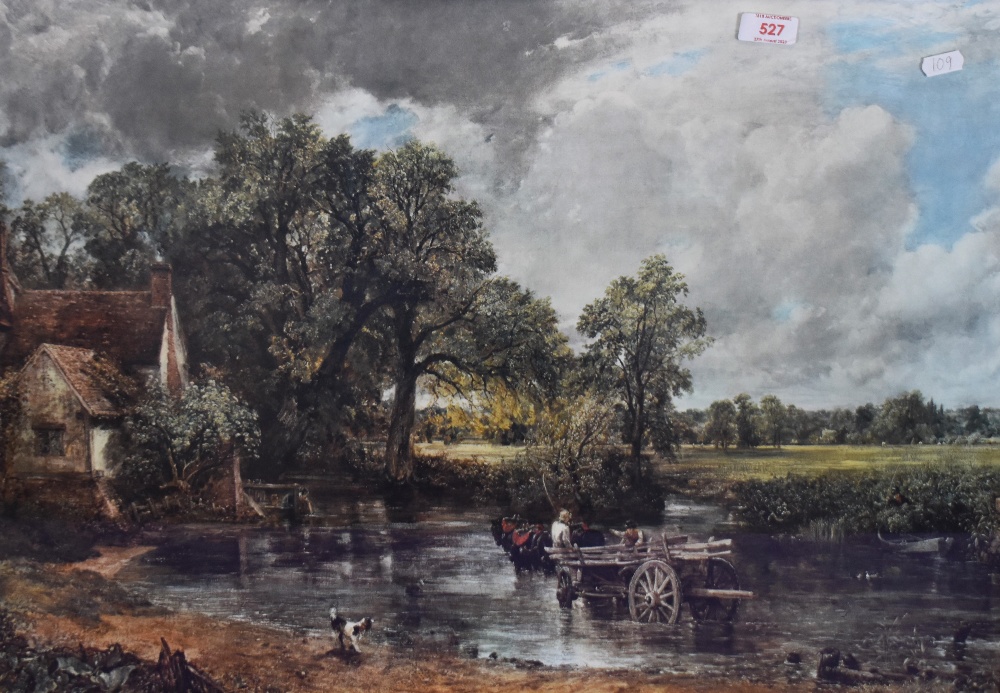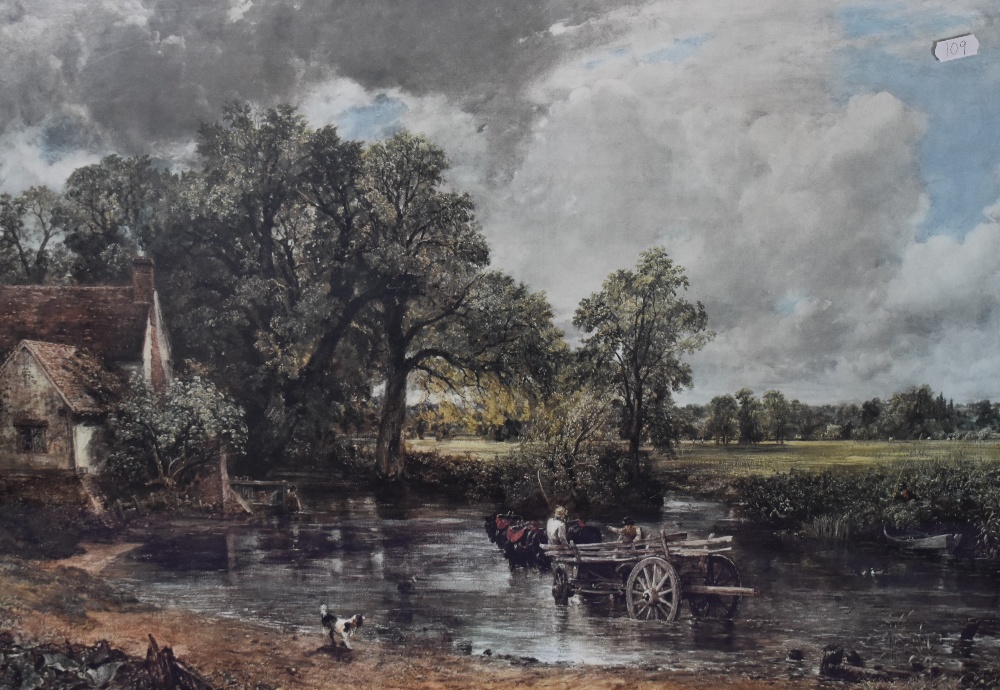John Constable RA (British, 1776-1837) Study of Trees c. 1802-3 pencil on buff laid paper h:18 w:24 cm Provenance: Probably Leggatt Brothers, London, 1899; H A Sutch; Leggatt Brothers, 1952; by descent to the present owner (please refer to introduction by Anne Lyles for further information on provenance) One of the most important early influences on Constable's drawing style was that of fellow Suffolk artist, Thomas Gainsborough ( 1727-88 ). In 1799, when staying with friends in Ipswich, Constable explored the surrounding countryside and found it of great inspiration 'for a landscape painter', declaring 'I fancy I see Gainsborough in every hedge and hollow tree' (letter to J.T.Smith, 18 August 1799; John Constable's Correspondence: II: Early Friends and Maria Bicknell (Mrs Constable), ed R.B.Beckett, Suffolk Records Society, Ipswich 1964, p.16). However, it was not until Constable met George Frost ( 1742-1821), probably around 1802, that he began making drawings in close imitation of Gainsborough's style. Frost was a clerk at the Ipswich Blue Coach Office and was a passionate admirer and collector of Gainsborough's drawings, as well as a talented amateur draughtsman. Constable struck up a friendship with Frost, and the two artists would often make sketches together in imitation of Gainsborough's manner, or even make copies after some of Gainsborough's drawings in Frost's collection. Indeed, Frost's and Constable's drawings produced at this period have often become confused (see I. Fleming-Williams and L.Parris, The Discovery of Constable, 1984, pp.159-77). In this example, Constable experiments with two different characteristics of Gainsborough's early drawing style, his distinctive diagonal shading to represent masses and forms, and the use of wriggly lines to define the contours of foliage. John Constable RA at Cheffins Fine Art, 5th & 6th March 2014 Introduction by Anne Lyles: This remarkable group of drawings - seven by John Constable, and one attributed to his son, Lionel Constable - can be traced back to the stock of London fine art dealers Leggatt Brothers, who handled a large quantity of Constable's sketches in oil, watercolour and pencil in the late nineteenth and early twentieth centuries. The vendor's father purchased this group of drawings from Leggatt Brothers in 1952, for £500. The drawings had been committed for sale by H.A. Sutch. Sutch was also a London art dealer who, together with Fredrick C. Williams had been in partnership with William Lawson Peacock with premises in Duke Street St James and Bond Street as well as in Princes Street, Edinburgh. Following Peacock's death in 1921, Sutch and Williams opened a gallery of their own, the United Arts Gallery, at 23a Bond street, where Sutch specialised in the Old Master side of the business ( American Arts News, vol 20, no.5, Nov 12, 1921). As well as these eight drawings, Sutch is also recorded as having owned two other Constables: one, a pencil drawing, Dedham: Rain coming on, now in the Henry E. Huntington Library and Art Gallery, San Marino, California (G.Reynolds, The Early Paintings and Drawings of John Constable 2 vols, Yale University Press, New Haven & London, 1996, no.14.75, plate 1220); the other, a watercolour, Bristol House and Terrace, Putney Heath, in a private collection (G. Reynolds, The Later Paintings and Drawings of John Constable 2 vols, Yale University Press, New Haven & London, 1984, no.18.18, plate 45. Sutch's name is mistakenly given under the provenance for this entry as H.S.Sutch, but is correctly referred to as H.A. Sutch in Reynolds's earlier Catalogue of the Constable collection in the Victoria & Albert Museum, 2nd edition, 1973, HMSO, pp.119-20 where he discusses another version of Bristol House in that collection). The latter work, Bristol House and Terrace, Putney Heath (R.18.18)- although one of three versions of the subject - is very likely to have been the example shown, as no. 109, in an important exhibition of Constable's
John Constable RA (British, 1776-1837) Study of Trees c. 1802-3 pencil on buff laid paper h:18 w:24 cm Provenance: Probably Leggatt Brothers, London, 1899; H A Sutch; Leggatt Brothers, 1952; by descent to the present owner (please refer to introduction by Anne Lyles for further information on provenance) One of the most important early influences on Constable's drawing style was that of fellow Suffolk artist, Thomas Gainsborough ( 1727-88 ). In 1799, when staying with friends in Ipswich, Constable explored the surrounding countryside and found it of great inspiration 'for a landscape painter', declaring 'I fancy I see Gainsborough in every hedge and hollow tree' (letter to J.T.Smith, 18 August 1799; John Constable's Correspondence: II: Early Friends and Maria Bicknell (Mrs Constable), ed R.B.Beckett, Suffolk Records Society, Ipswich 1964, p.16). However, it was not until Constable met George Frost ( 1742-1821), probably around 1802, that he began making drawings in close imitation of Gainsborough's style. Frost was a clerk at the Ipswich Blue Coach Office and was a passionate admirer and collector of Gainsborough's drawings, as well as a talented amateur draughtsman. Constable struck up a friendship with Frost, and the two artists would often make sketches together in imitation of Gainsborough's manner, or even make copies after some of Gainsborough's drawings in Frost's collection. Indeed, Frost's and Constable's drawings produced at this period have often become confused (see I. Fleming-Williams and L.Parris, The Discovery of Constable, 1984, pp.159-77). In this example, Constable experiments with two different characteristics of Gainsborough's early drawing style, his distinctive diagonal shading to represent masses and forms, and the use of wriggly lines to define the contours of foliage. John Constable RA at Cheffins Fine Art, 5th & 6th March 2014 Introduction by Anne Lyles: This remarkable group of drawings - seven by John Constable, and one attributed to his son, Lionel Constable - can be traced back to the stock of London fine art dealers Leggatt Brothers, who handled a large quantity of Constable's sketches in oil, watercolour and pencil in the late nineteenth and early twentieth centuries. The vendor's father purchased this group of drawings from Leggatt Brothers in 1952, for £500. The drawings had been committed for sale by H.A. Sutch. Sutch was also a London art dealer who, together with Fredrick C. Williams had been in partnership with William Lawson Peacock with premises in Duke Street St James and Bond Street as well as in Princes Street, Edinburgh. Following Peacock's death in 1921, Sutch and Williams opened a gallery of their own, the United Arts Gallery, at 23a Bond street, where Sutch specialised in the Old Master side of the business ( American Arts News, vol 20, no.5, Nov 12, 1921). As well as these eight drawings, Sutch is also recorded as having owned two other Constables: one, a pencil drawing, Dedham: Rain coming on, now in the Henry E. Huntington Library and Art Gallery, San Marino, California (G.Reynolds, The Early Paintings and Drawings of John Constable 2 vols, Yale University Press, New Haven & London, 1996, no.14.75, plate 1220); the other, a watercolour, Bristol House and Terrace, Putney Heath, in a private collection (G. Reynolds, The Later Paintings and Drawings of John Constable 2 vols, Yale University Press, New Haven & London, 1984, no.18.18, plate 45. Sutch's name is mistakenly given under the provenance for this entry as H.S.Sutch, but is correctly referred to as H.A. Sutch in Reynolds's earlier Catalogue of the Constable collection in the Victoria & Albert Museum, 2nd edition, 1973, HMSO, pp.119-20 where he discusses another version of Bristol House in that collection). The latter work, Bristol House and Terrace, Putney Heath (R.18.18)- although one of three versions of the subject - is very likely to have been the example shown, as no. 109, in an important exhibition of Constable's














Testen Sie LotSearch und seine Premium-Features 7 Tage - ohne Kosten!
Lassen Sie sich automatisch über neue Objekte in kommenden Auktionen benachrichtigen.
Suchauftrag anlegen